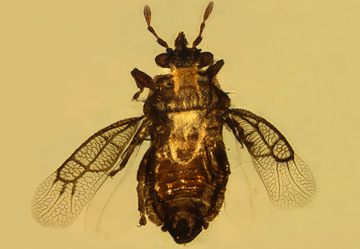Abstract
The Carboniferous outcrop near Avion, in the Department of Pas-de-Calais, northern France, is very rich in fossil insect wings, which are preserved alongside thousands of plant fragments. Its entomofauna is very diverse, including representatives of the Palaeodictyoptera, Odonatoptera, Archaeorthoptera, Caloneurodea, Paoliida, Dictyoptera, Plecoptera, and the oldest representatives of the clades Acercaria and Holometabola (Nel et al., 2013, Prokop et al., 2013, 2014; Coty et al., 2014; Schubnel et al., 2019a, b). The fossil insects were found in ‘Terril N 7’, a slag heap located in the Avion area comprising Moscovian-aged sediments derived from Liévin coal mines 3 and 4, specifically the Bolsovian or Westphalian C (311–308 Ma) ‘faisceaux de Ernestine’, and the Asturian or Westphalian D (308–306 Ma) ‘veines Arago, Dusouich, Marthe’ informal beds (Bruno Vallois, 2013, pers. comm.).
References
Aristov, D.S. & Rasnitsyn, A.P. (2008) Position and taxonomy of the Permian fossil insect family Permembiidae (Insecta: Palaeomanteida = Miomoptera). Russian Entomological Journal, 17, 327–334.
Béthoux, O. (2005) Wing venation pattern of Plecoptera (Insecta: Neoptera). Illiesia, 1, 52–81.
Béthoux, O., Cui, Y.Y., Kondratieff, B., Stark, B. & Ren, D. (2011) At last, a Pennsylvanian stem-stonefly (Plecoptera) discovered. BMC Evolutionary Biology, 11, 1–12.
https://doi.org/10.1186/1471-2148-11-248
Brauckmann, C. & Herd, K.J. (2002) Insekten-Funde aus dem Westfalium D (Ober-Karbon) des Piesberges bei Osnabrück (Deutschland). Teil 1: Palaeoptera. Osnabrücker Naturwissenschaftliche Mitteilungen, 28, 27–69.
Carpenter, F.M. (1933) A new megasecopteron from the Carboniferous of Kansas. University of Kansas Science Bulletin, 21, 365–367.
Carpenter, F.M. (1967) Studies on North American Carboniferous insects. Part 5. Palaeodictyoptera and Megasecoptera from Illinois and Tennessee with a discussion of the order Sypharopteroidea. Psyche, 74, 58–84.
https://doi.org/10.1155/1967/58796
Coty, D., Háva, J., Prokop, J., Roques, P. & Nel, A. (2014) New archaeorthopteran insects from the Late Carboniferous of the Nord and Pas-de-Calais basins in northern France (Insecta: Cnemidolestodea, Panorthoptera). Zootaxa, 3878, 462–470.
https://doi.org/10.11646/zootaxa.3878.5.4
Handlirsch, A. (1911) New Paleozoic insects from the vicinity of Mazon creek, Illinois. American Journal of Science, (4), 31, 297–326, 353–377.
https://doi.org/10.2475/ajs.s4-31.185.353
Prokop, J. & Nel, A. (2011) New Middle Permian palaeopteran insects from Lodève Basin in southern France (Ephemeroptera, Diaphanopterodea, Megasecoptera). In: Shcherbakov, D.E., Engel, M.S. & Sharkey, M.J. (Eds), Advances in the systematics of fossil and modern insects: Honouring Alexandr Rasnitsyn. ZooKeys, 130, 41–55.
https://doi.org/10.3897/zookeys.130.1311
Nel, A., Roques, P., Nel, P., Prokin, A.A., Bourgoin, T., Prokop, J., Szwedo, J., Azar, D., Desutter-Grandcolas, L., Wappler, T., Garrouste, R., Coty, D., Huang, D., Engel, M.S. & Kirejtshuk, A.G. (2013) The earliest-known holometabolous insects. Nature, 503, 257–261.
https://doi.org/10.1038/nature12629
Prokop, J., Roques, P. & Nel, A. (2014) New non-holometabolous insects from Pennsylvanian of Avion locality in Pas-de-Calais, France (Insecta: ‘Exopterygota’). Alcheringa, 38, 155–169.
https://doi.org/10.1080/03115518.2014.848620
Prokop, J., Tippeltova, S., Roques, P. & Nel, A. (2013) A new genus and species of Breyeriidae and wings of immature stages from the Upper Carboniferous, Nord-Pas-de-Calais, France (Insecta: Palaeodictyoptera). Insect Systematics and Evolution, 44, 117–128.
https://doi.org/10.1163/1876312X-44032098
Schubnel, T., Perdu, L., Roques, P., Garrouste, R. & Nel, A. (2019a) Two new stem-stoneflies discovered in the Pennsylvanian Avion locality, Pas-de-Calais, France (Insecta: ‘Exopterygota’). Alcheringa, 43, 430–435.
https://doi.org/10.1080/03115518.2019.1569159
Schubnel, T., Roberts, D., Roques, P., Garrouste, R., Desutter-Grandcolas, L. & Nel, A. (2019b) Moscovian fossils shed light on the enigmatic polyneopteran families Cacurgidae and Eoblattidae (Insecta: ‘Eoblattida’, Archaeorthoptera). Journal of Systematic Palaeontology, in press.
https://doi.org/10.1080/14772019.2019.1627595
Sharov, A.G. (1968) Filogeniya ortopteroidnykh nasekomykh. Trudy Paleontologicheskogo Instituta Akademiya Nauk S.S.S.R., 118, 1–216, Moskva. [In Russian. Translated to English in 1971: Phylogeny of the Orthopteroidea. Israel program for scientific translations, Keter Press, Jerusalem: 1–251].
Shcherbakov, D.E. (2015) Permian and Triassic ancestors of webspinners (Embiodea). Russian Entomological Journal, 24, 187–200.
https://doi.org/10.15298/rusentj.24.3.01
Tan, J.J. (1980) On the Permian Diaphanopterodea and Homoptera of Inner Mongolia, China. Acta Zootaxonomica Sinica, 5, 159–165.

